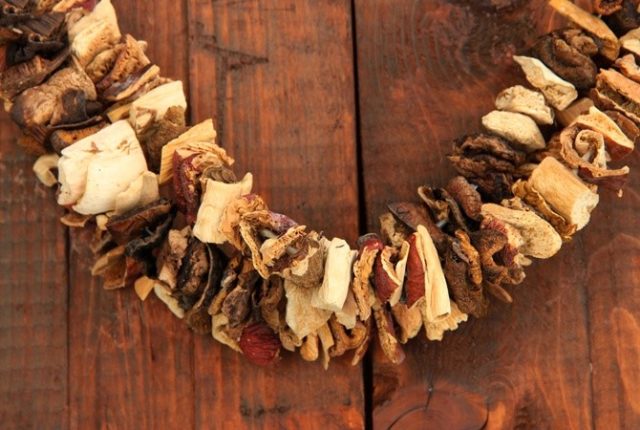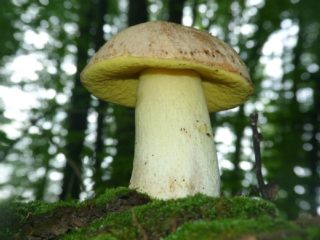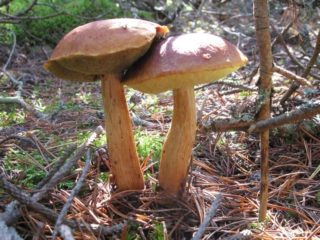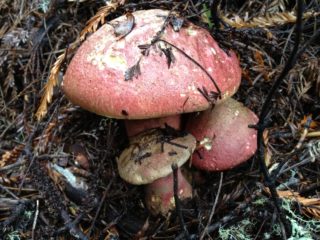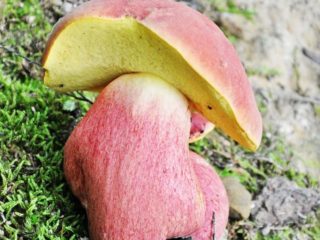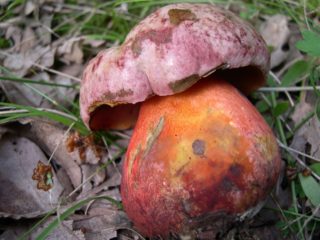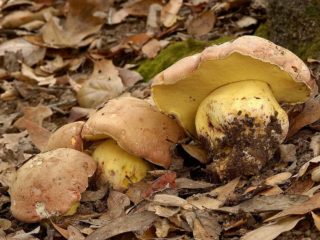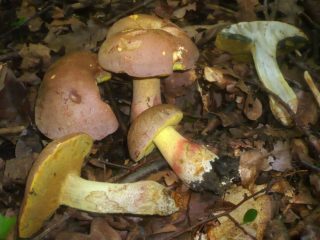Content
The yellow boletus (boletus) is also known in Russian sources as the Yunkville boletus. But this erroneous name did not come from the name of the famous scientist, but from the Latin word “junquillo”, which means “light yellow”. You can also find the Latin name of the species – Boletus junquilleus. The mushroom belongs to the Boletaceae family, Borovik genus.
What do yellow boletus mushrooms look like?
Young specimens have a convex, spherical cap with a diameter of approximately 5 cm, more mature ones have a flat, cushion-shaped, prostrate cap, up to 16-20 cm in diameter. Its surface is smooth, matte, velvety, slightly wrinkled in dry weather, and covered with mucus after rain. The color of the cap is yellow or light brown.
The leg is round, fleshy, dense, not hollow inside.In appearance it resembles a yellow potato tuber. Its height can reach up to 12 cm, and its diameter up to 6 cm. The color is bright yellow or cream, the surface is covered with small brown scales.
The pulp is dense, yellow, and there is no characteristic mushroom aroma. At the cut site it darkens and may turn slightly blue.
The thickness of the tubular layer is 1.5-3 cm, the color is yellow, in old mushrooms it becomes olive. The tubes are short, free with a notch, their length does not exceed 2 cm, the color is bright, yellow, and when pressed on the fruiting body it can become darker.
The spores are smooth, fusiform, light yellow. Olive colored spore powder.
Where do yellow boletus grow?
This heat-loving mushroom is distributed throughout Western Europe, in the Carpathian region, Polesie, and in the Forest-steppe. You can find it in deciduous forests where oak or beech grows. In Russia, yellow boletus can be found in the Far East or Crimea. It is practically not found in the European part of the country.
Is it possible to eat yellow boletus mushrooms?
This is an edible, completely safe mushroom. It is eaten fresh, dried or pickled. You can prepare any mushroom dishes from it - boil, fry and stew. In the category of nutritional value, the mushroom belongs to the second group.
Collection rules
Yellow boletus is harvested during its fruiting season - from July to October. The peak growth of this species occurs in mid-August or early September. Depending on weather conditions, these dates may shift by a week. You can find yellow boletus under oak or beech; the species does not grow in coniferous forests.The mycelium bears fruit abundantly in a damp, warm place, usually in a lowland at the edge of a forest.
You should go on a mushroom hunting trip a few days after heavy rain. You should look for them in well-lit, sunny edges and clearings, in sandy soil. If the cap of a yellow boletus appears from under the fallen leaves, you can find several more of its fellows nearby, since the mushroom grows in large families.
The fruiting body is cut off with a knife or broken off - this does not affect the fruiting of the mycelium, since its spores are located deep under the soil.
It is better not to take very small mushrooms; in a week a 5-gram baby will turn into a 250-gram strong one. Sometimes there are specimens whose weight reaches 1 kg.
Use
Boletuses are consumed and stored for the winter within 24 hours after they are collected. This way they retain maximum benefits and taste. Before stewing or boiling, the yellow boletus is poured with salted water so that the worms, if any, float to the surface.
Any mushroom dishes are prepared from the fruiting body: soups, roasts, sauces, filling for pies and dumplings. A young mushroom is boiled or stewed for no more than 20 minutes; an overripe one will take half an hour.
Yellow boletus can be dried. First, wash it thoroughly, remove moisture with a paper towel, and string it on a thread.
These mushroom beads are hung in a dry, warm place and left until winter. It is enough to soak dry boletus in cold water for half an hour, then cook any dish you like from it.To give a richer creamy taste, dried mushroom is soaked in milk. Dried boletus mushrooms can also be ground into powder and added to sauces as a seasoning.
You can prepare yellow boletus for the winter by freezing. Thoroughly washed, dried mushrooms are divided into small portions, packed in bags and placed in the freezer. In winter, the fruiting body is thawed and prepared in the same way as a freshly harvested boletus.
Conclusion
Yellow boletus is a member of the family of porcini mushrooms, which are distinguished by their excellent taste and rich aroma. The species is rarely found in Russia, as it is heat-loving. It differs from other members of the family in its bright yellow color and is suitable for preparing any mushroom dishes.


